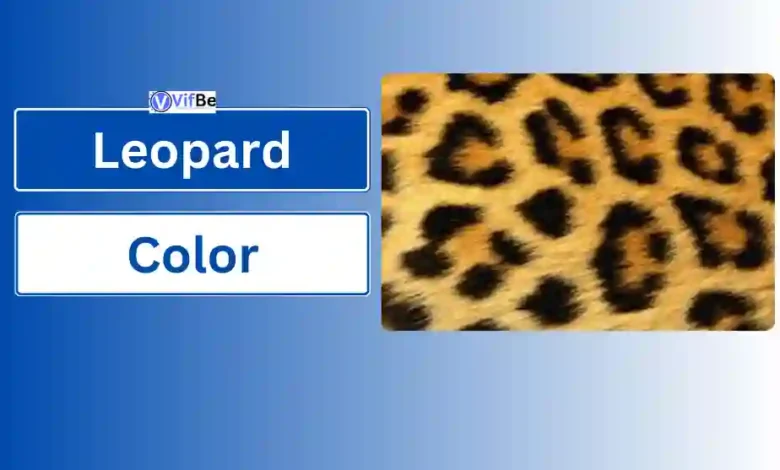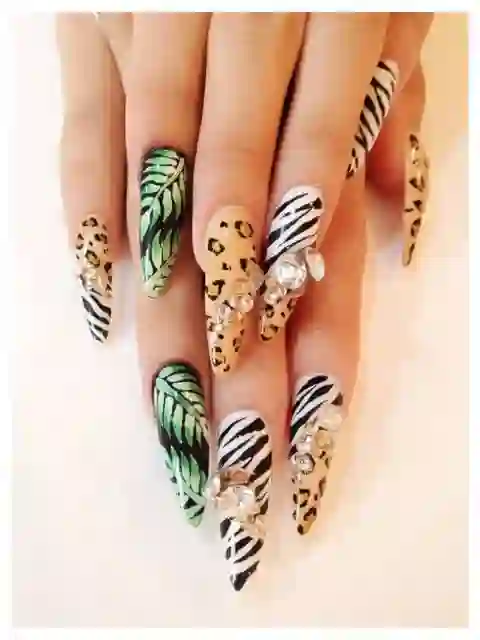Leopard Color Palette for a Wild Aesthetic

Leopard color scheme with earthen and daring shades has been one of the most beautiful and appealing designs right from the time they have been discovered. Influenced by the wild, the colors of the fur of the leopards like golden yellows, deep browns and black spots are fonts of adventures and elegance in a number of design spheres.
And while it applies to the crazy designs of clothing, shoes, bags, interior, accessories etc. the color scheme of the leopard can be used in any fashion. Here, it will be our focus to describe ways through which the leopard color scheme can help the enhance the aesthetics of your wardrobe and other items such as bags and even your house interior.
Leopard as a Color Scheme
In its essence, leopard colors are natural colors accentuated by the addition of daring shades that resemble leopard skin. The most utilized tones are the golden yellows, deep red spectrum browns and intense blacks with contrasting touches of white and caramelize beige.
These tones are given according to the animal’s coat, and such shades connect to wildness but at the same time, elegance, and the touch of classics. To incorporate this palate into design means the enhancement of the curricular-earthiness, exotic appeal of any scheme.
Key Elements of the Leopard Color Palette:

Golden Yellow: It reminds one of the glow of the animal’s dense and plush chubby coat.
Rich Browns: Earthy browns work as the grounding color and provide that dark depth to the beautiful tones of blond.
Black Spots: The not very large black patches seen in the fur coat of a leopard add contrast and make the color domination stronger.
Beige and Cream: These shades are combined with the brighter colors providing gentler vibrations to tie out with stronger ones.
Leopard Print Fashion: A Wild Style Statement
Definitely one of the most popular applications of leopard color scheme is in leopard spot fashion. This daring, animal-featured texture is perhaps one of the most recognizable prints in fashion history and it has been used on apparel, accessories, shoes and bags. Leopard print as a hue is neutral by its nature and looks fabulous when combined with other neutrals or other flashy prints for great ensembles.
Leopard print does not necessarily have to be placed throughout one’s garment; it can be placed as trims such as scarfs or handbags or can be a dress or jacket. The shades of the leopard color make the pattern very versatile because they can easily be incorporated into any season’s clothes. Leopard print also looks nice when mixed with earthy colors such as beige, black or tan While bright colors like red or green will give lover a high fashion and playful look.
Key Fashion Tips for Leopard Prints:
Pair with neutrals: There is no better way to wear leopard print than supplementing it with plain and innocuous colors such as beige, taupe, or ivory.
Mix with other animal prints: Overlapping leopard skin with other sharp animal skin prints including the zebra or cheetah look is fashionable and savannah like.
Add pops of color: Place the focus on the traditional speckled color by adding complementary colors of deep greens or rich reds.
Interior Design with Leopard Colors: A Wild Aesthetic at Home
Leopard can also be easily incorporated into interior design since its color combination is easily feasible. Whether you want to achieve an African safari look, or bring more warmth, texture and a touch of wildness into your living room, bedroom, or office space, the colors of a leopard’s coat can do just that. Therefore, interior design in the home area can include animal print dimensions to get a connection to nature since the textures of wooden, leather, and the prints inspired by animals provide a more natural look.
Ideas for Leopard-Inspired Home Decor:
Leopard Print Upholstery: Leopard print can also be incorporated into bigger furniture items such as chairs, sofas or even into cushions. This daring change immediately brings attitude into a room especially when compared with pastel shades and/or natural materials.
Wall Colors: Pastel tones of beige, light shades of brown or warm yellow on walls can bring native African spirit. Chocolate brown or black must be used at the accent to give the decors a contrast resembling the spots of a leopard skin.
Wild-Inspired Decor: The use of some animal motifs including the zebra patterned rugs or cheetah patterned curtains can help in the making of a continuous wild life theme outlook from the house.
Color Psychology of Leopard Colors: Impact on Mood and Perception
The effect of the colours in the leopard colour range is not only aesthetic: they make our eyes happy and affect our mood. For some reason earth tones, especially the ones used in leopard prints like browns and yellows have a stabilizing or calming effect on me. Such colors regarding themselves with the elements of nature and warmth making the atmosphere in the house warm welcoming. However, the darker shades provide the contrast as well as muskiness which, in its turn, provide the energy and strength’s sensual memories.
The color psychology of leopard colors show that such shades will greatly improve the feelings of confidence, power and adventure. Regardless of whether W’Hampton relates to a clothing designer or an interior design, the warm, earthly colours ensure feelings of relaxation as well as security, the sharp black undertones on the other hand ensure a sophisticated and mysterious aura.
Natural Inspiration for Design: Drawing from the Wild

As any similar structures and patterns in nature, every leopard’s spot is unique and it is fascinating. This organic, imperfect beauty has had a role in many modern design trends, particularly, natural designs. The wild theme relies more on nature and its diverse colors such as the jungles green color, the neutrals of the savanna etc. Designers can implement earth-y hues such as that used in the leopard skin colors and thus help design environments that give the impression of exploration.
Nature-Inspired Design Tips:
Organic Materials: Try and use natural materials such as wood, stone and leather when designing clothes in leopards colours or those of the earth.
Incorporate Bold Patterns: Do not limit yourself to the colors of leopard spot and use them together with other other brave pattern designs including the flower or geometrical pattern to get a modern and daring nature look.
Use Earthy Hues: Slash the rates of the leopard-inspired tones with other nature colors like terracotta, moss green or rust to create a warm environment of the room.
Leopard Colors and Other Patterns and Colors Combination
Leopard prints are vibrant and noticeable all by themselves, but it still possible to combine them with other patterns and colors and get rather nice outfits. One has to remember that when combining leopard colors with other patterns it is quite effective to mesh a powerful leopard look with delicate hints.
For instance, leopard print when combined with stripes, flowers or other animal skin also provides an innovative and spirited feel. Other colors that differ, but are related to the shades of the leopard color palette such as deep greens, blues, or red are excellent because they contrast with the warm tones.
Tips for Mixing Leopard Prints:
Mix with geometric patterns: Leopard print combined with clean lines, geometrics will look chic & modern.
Use complementary colors: To paint a splendid picture place deep green, red orange or similar colors that are on the opposite side of the color wheel to the shades of the leopard print on the background.
Balance with neutrals: To avoid any overwhelming feeling while mixing patterns, it is imperative to incorporate primary and equalize them with, for example, beige, taupe, or gray.
Conclusion:
In recent years, leopard print has become a popular trend whether you are trying to add these colors into your outfits or redesign your living space. The natural colors of leopard are warm ochre colors of golden yellows, deep browns, black and white are beautiful colors that offer a rich and wild touch to any home and make a wonderful style statement. With these natural colors and mixing them with other colors and patterns, it is possible to express the spirit of a wild in your cloths and home furnishing and, at the same time, make a strong but a classic statement.
FAQ Related Leopard Color
What is the leopard color palette?
These range from basic shades originating from natural material found in leopards’ skin such as light chocolate brown, dark-brown, beige with shadings of yellow and light oranges. Key color tones are warm golden yellow, good old brown, black and white. These colours are imposed by still ‘subtle’ ones like beige or cream to avoid absolutely overwhelming the walls with darkness.
What is the significance of leopard print in interior design?
The color scheme of leopard brings a wild or a safari like appearance in interiors. Whether it is in the form of fabric that uses leopard print or colors in pillows or walls, these natural colors together with some texture such as wood and leather add drama to the space and makes it welcoming.
How do leopard colors affect the mood and perception?
Speaking of colors, one cannot but mention the shades of leopard, which is rather close to the earth tones – they make a person feel calm and recuperated, the shades are warm. Those black accents do look risky, they energize, make one confident, and feel strong. All in all, it is well associated with adventurous, powerful and natural connotation.
What are complementary colors to pair with the leopard color palette?
Leopard print can be easily combined with other colors since its shades range from warm and muted hues of brown and grey – it goes perfectly with deep green, red, and even mustard. Such differences give the brightness and boost up the natural leopard print with the addition of a modern touch into earth tones.
How can I create a wild aesthetic in my home decor?
It is a general rule of thumb that the shades of a color reflected can be used throughout a room and if green and yellow hues don’t work with the other furnishings in the room, then natural prints can be used in dresses, mats, and even curtains.





One Comment